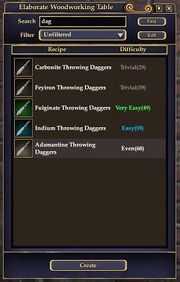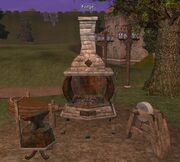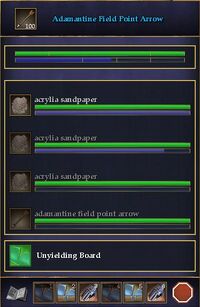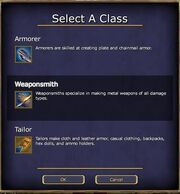| ||||
Your character actually has two classes: an Adventure class and a Tradeskill class. Your Tradeskill class has its own experience bar, and earns its own levels. You can see these in your Persona window. You even have a separate section in your Knowledge Book for Tradeskill abilities.
You can choose to develop a tradeskill as a side activity to your adventuring career, or you can focus your character exclusively on tradeskill progression. EQ2 was designed to make the tradeskill career interesting and rewarding in its own right. In this guide, we'll introduce you to the tradeskill classes and the mechanics of crafting items.
How it Works
Initially, you are a generic Artisan. If you choose to develop your tradeskill, then you'll choose a Tradeskill Class later, as you rise in levels.
The general process of creating an item looks like this:
- Scribe the recipe in your Recipe Book.
- Get the materials that are specified in the recipe.
- Find the appropriate apparatus for this tradeskill.
- Start the crafting process.
- Use your crafting skills to create the item.
We'll discuss these steps in a bit more detail. Then afterward, we'll take a survey of the tradeskill classes that you can choose from.
Your Recipe Book

The Recipe Book
- Main Article: List of Recipes
Press V to open your Recipe Book, or choose "Recipes" from the EQII Menu. Your Recipe Book will also open whenever you click on a crafting station. Here you have a list of all recipes that you have scribed. If you're a new Artisan then the list of recipes may be short; but after a few levels the list of recipes will get very long. A filter helps you to narrow down the list to the types of recipes that you're interested in, or if you know the name of the item you want to create, then you can find a recipe by its name.
When you click on a recipe in the Recipe Book, you're shown the ingredients that are required, and whether you currently possess those ingredients in your inventory.
Learning New Recipes
To add a recipe to your book, you obtain the recipe on a scroll, right-click it and choose "Scribe". This is the same process that's used to learn a new spell or combat art.
There are two "tiers" of recipes to be found in EQ2:
- Essential Recipes: these are sold by Crafting Trainer NPCs around Norrath. Each time you gain a level in your tradeskill, you can learn a new book of essential recipes for that level. These recipes will create Handcrafted items.
- Advanced Recipes: these are found by other means, usually in treasure chests dropped by monsters, or occasionally from certain quests. The only exception is the first tier (levels 2 through 9), which are sold by Crafting Trainer NPCs. These recipes will create Mastercrafted items.
Material and Equipment
Getting Materials
- Main Articles: Fuel, Harvestables
Crafters need raw materials in order to make their goods. The recipe in your Recipe Book will tell you what materials you need when you examine it. There are two types of materials that you'll need:
- Fuel and basic materials purchased from NPC merchants. These are readily available next to almost all crafting stations.
- Raw materials harvested from out in the world. You can buy raw materials that other players collect, through the Broker, or you can go out and harvest the raw materials yourself.
As you gain each new tier of tradeskill level, your raw materials will come from the next tier of outdoor zone, which means that it takes better harvesting skills to harvest them, and the harvesting will take place in more dangerous zones. (See the guide to Tiers.) There are three types of raw materials to be found out in the world, that you can use in your recipes:
- Common materials: these items are used in Essential recipes, and will create Handcrafted items.
- Uncommon materials: these items are used to create Imbued items (whether handcrafted or mastercrafted).
- Rare materials: these items are used in Advanced recipes, and will create Mastercrafted items.
Harvesting tools exist that can help in the tedious task of harvesting. The common tools, made by woodworkers, reduce the time to complete a harvesting attempt. The tinkered tools also provide a boost to your harvesting skill, increasing the chance for success and the chance to find rare materials.
Finding a Crafting Station

A crafting station.
- Main Article: Tradeskill Stations
Crafting stations provide artisans with locations at which to make their wares. In order to work on your tradeskill, you must stand near one of these crafting stations. You don't have to target the crafting station, but if you click on it, your Recipe Book will open automatically. Each type of artisan works at a different type of crafting station (there are seven types in all).
You'll find crafting stations scattered around all of the cities and various villages in Norrath. In the old cities, crafting stations can also be found in traditional tradeskill instances. Some special crafting stations are even found in the more dangerous adventuring locations, where you may need the assistance of adventurers to reach and use it. If you belong to a higher-level guild, you may even be able to buy crafting stations for your own house.
The Crafting Process

The crafting window. The event "Unyielding Board" is currently taking place.
To begin crafting, select a recipe in your Recipe Book and press Create. If you have all of the necessary ingredients, then the crafting process begins. You'll see two bars in your crafting window: a blue progress bar, and a green durability bar.
Your goal is to make the blue bar fill up faster than the green bar shrinks.
- If the blue bar fills up, then you've successfully created the item.
- If the green bar shrinks below a certain level, then the quality of the item will be lower.
- If the green bar shrinks all the way, then you've failed to create the item.
Crafting Events
Every few seconds during the crafting process, an event occurs. This is not too different from combat. These events can lower your durability, or slow your progress. Occasionally you'll even get a beneficial event. If left unchecked, these events might cause you to fail to create the item. You'll use your Crafting Skills to respond to the events.
Each time an event occurs, its name and icon are shown in the bottom left of the crafting window. Click your crafting skill that has the same icon, within a few seconds, to respond to the event and reduce its negative effects.
Your Crafting Skills
- Main Article: Tradeskill Skillsets
Your crafting skills are helpfully included within the Crafting Window, along the bottom, so you don't have to hunt through the Knowledge Book to find them. You can examine them and activate them directly in the Crafting Window.
You have three Crafting Skills for each tradeskill. You'll find them in your Knowledge Book, in the Tradeskill section. Actually, you'll find lots of various crafting skills in the Knowledge Book, but you'll only need three of them for each particular recipe. Every 20 levels, you receive an upgraded version of each ability.
As you get more familiar with your Crafting Skills, you can start using them in between crafting events, to try to hasten the crafting process or to improve the durability. However, notice that there's a cooldown timer on each crafting skill. There's always a chance that you'll need the skill for an event in the next few seconds, so there's inherent risk in using the skill when it's not needed.
Tradeskill Classes
- Main Article: Tradeskilling

The tradeskill classes are organized in a hierarchical fashion. You begin as a generic Artisan, and then specialize at level 10 and again at level 20.
- Artisan: At levels 2-9 you are a generic Artisan, and can try all of the tradeskills.
- Class: At level 9 you must choose one of three classes: Craftsman, Outfitter, or Scholar. You'll belong to your chosen class from levels 10-19.
- Subclass: At level 19 you must choose one of three subclasses. You will belong to your chosen subclass for the rest of your tradeskilling career.
- Craftsmen must choose between Provisioner, Woodworker, and Carpenter.
- Outfitters must choose between Armorer, Tailor, and Weaponsmith.
- Scholars must choose between Alchemist, Jeweler, and Sage.
Changing Your Mind
You can respecialize your tradeskill whenever you choose - but be warned! Changing your mind means you are converted back into a level 9 Artisan. You lose all of your tradeskill experience and recipes beyond level 9, and must earn all of those levels and recipes from scratch.
- To respecialize your tradeskill, visit a Tradeskill Career Counselor NPC in any of the cities.
Secondary Tradeskills
In addition to your Tradeskill Class, you can choose to adopt one of the following Secondary Tradeskills:
- Tinkerer: make a wide variety of gadgets, that cast useful spells, from common harvested items.
- Transmuter: break down "valuable" items into basic components, then create Adornments with them.
Secondary tradeskill classes are actually skill-based:
- Your secondary tradeskill is described by a skill number, rather than a level.
- Your secondary tradeskill is listed in the Skills -> Tradeskills tab of your Persona window.
- Your secondary tradeskill is limited to 5 times your highest level - either your Adventure level or your Tradeskill level.
Your Tradeskill Career
- Main Article: Tradeskill Timeline
Tutorials and Service Quests
- Main Articles: Crafting Tutorial Timeline, Craftsman Timeline
Work Orders and Rush Orders
- Main Article: Tradeskill Writs
Commissioned Work for Other Players
- Main Article: Commission System
Tradeskilling Faction
- Main Article: Tradeskilling Factions
The Trappings of Success
- Main Article: Artisan Epic Timeline
(insert info about earning home crafting stations)
Harvesting
- Main Article: Harvesting
Harvesting Tools
- Main Article: Harvesting Tools
